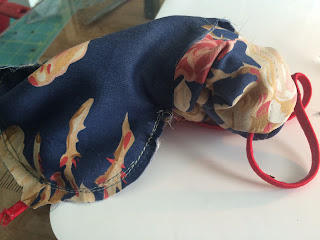 |
| Quilted eye pillow by Linda Theil |
I always thought eye pillows were only for Thirties-era starlets until I learned in yoga class how nice a weighted eye pillow feels when you are resting. For this eye pillow that I made, I used an old worn sheet that I love, but you can use any soft scrap you have available. Old flannel p.j.s would make nice eye-pillows. An eye pillow is also a warmhearted gift for travelers and visitors.
You can download a printable PDF file for the "Eye-pillow pattern 2016" by clicking on the link. Or you can draw your own pattern using the drawing shown here. Each block should be 1/4-inch.
To make an eye pillow, you will need:
- 4 pieces of fabric 11-inches wide by 5.5-inches high
- 1 piece of cotton batting 10-inches wide by 4.5-inches high
- one elastic hairband, available in drug stores
- one cup buckwheat hulls or rice
Cut one eye-pillow piece from cotton batting, do not add seam allowances to pattern piece. (Use solid, dark line on pattern piece.)
Cut four eye-pillow pieces from soft cotton or flannel fabric, adding 1/4-inch seam allowance around entire pattern piece. (Cut out pattern piece on solid, dark line; dotted line shows approximately where the seam allowance will be cut on fabric pieces.) Cut arrows pointing outward to show where elastic band will be sewn. (The photo above shows arrows as notches, but you will cut your arrows out, not notched inward.)
Pillow pieces cut out. Note that arrows are cut pointing outward, not notched inward.
Lay one pillow piece wrong-side up on table, put the batting piece on top of the pillow fabric. Put a second pillow fabric piece on top of the batting, right-side-up -- sandwiching the batting between two pieces of pillow fabric.
Machine quilt the three layers in whatever design you prefer. I used a walking foot for this step, for seaming the pillow pieces together, and for topstitching.
Put the two remaining pillow pieces together with wrong-sides-together. Pin, and stitch around outside edge of pieces to secure.
Cut the elastic hair band with a pair of scissors.
Cut off a 16-inch length of hairband. Save remaining elastic piece for another project, or discard.
Pin each end of elastic to RIGHT side of quilted pillow piece on each temple where marked with fabric arrows. Pin with rubber nubbed surface on headband facing up (if your band has rubber nubs). Leave about an inch of headband on either side of pillow, sticking outward, past seam allowance area. Baste in place on sewing machine.
Put remaining pillow piece on top of the quilted pillow piece, matching right sides together, and tucking headband between both layers.
Leaving a three-inch opening at the top of the pillow for turning, using a walking foot, stitch all layers together around the edge of the pillow pieces with a 1/4-inch seam allowance. Inspect seam, be sure the headband has not been caught in the seam, when satisfactory, double stitch seam to secure.
Turn the pillow right-side-out.
Eye pillow turned out with opening in top unstitched.
Measure one cup of buckwheat hulls, or rice.
Put buckwheat hulls or rice inside opening of stitched pillow.
Turn in opening edges and pin in place.
Push hulls away from stitching area and topstitch opening closed and continue topstitching around entire eye pillow. Check to make sure there are no holes where hulls might escape. Restitch to secure, if desired.
Cozy eye-pillow is ready to use.




















Comments